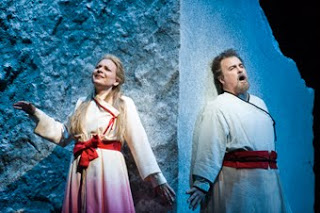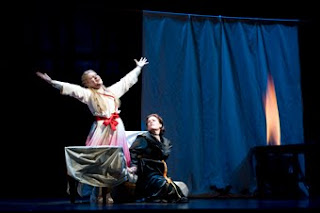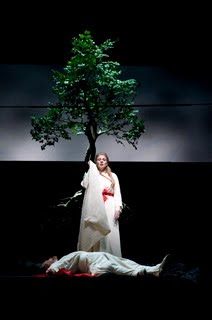Annalena Persson (Isolde) and Clifton Forbis (Tristan) let a rock come between them in Seattle Opera’s Tristan and Isolde. ©Rozarii Lynch photo.
Review: Tristan and Isolde at Seattle Opera. Music and libretto by Richard Wagner. Conducted by Asher Fisch. Directed by Peter Kazaras. Set and Costume Design by Robert Israel. Lighting Design by Duane Schuler. With Clifton Forbis, Annalena Persson, Margaret Jane Wray, Greer Grimsley and Stephen Milling. In German with English Captions. Seven performances from July 31 to August 21.
Once again, I waded into the breach and ventured forth to the Seattle Opera and the opening night of their production of Wagner’s classic opera of doomed love/lust, Tristan and Isolde and once again I have to preface my remarks with the reminder I’m not an expert on opera or classical music in general; I admire it and I respect it but a disc of great operas would not be one of my chosen “Desert Island Discs”. That being said, I always enjoy these opportunities to see these productions. The culture and ritual that surround the opera themselves is frequently as entertaining and engrossing as the actual performance on stage but the participants tend to be far older…
Tristan and Isolde is a tough row to hoe for the novice opera goer. Everything negative that is attributed to opera, the preconceived derision visited upon it, is readily apparent in this work. It is very, very long. Large, well fed singers stand on stage and sing quite loudly for long periods of time essentially repeating ad nauseum the same plot lines and motifs of the piece. The performers seldom interact with each other, move very slowly and with great effort (my companion for the evening called it “Teutonic Tai Chi”…) and there are looooong dramatic pauses. There is very little action in Tristan and Isolde and very few characters on stage. Wagner originally conceived of the piece as a way to make a fast buck; write a small cast, simply set, easy and inexpensive to produce work that would generate some revenue to aid him in completing the very ambitious and much larger and more expensively scaled “Ring Trilogy”. It is dark, moody, depressing and somberly paced. It is NOT a fun night at the opera, but it is an important work of art. I just wouldn’t recommend Tristan and Isolde as the first experience for someone interested in experiencing an opera; Mozart’s The Magic Flute or Rossini’s The Barber of Seville (both being done at Seattle Opera this season) are lighter, funnier and easier to digest works with strong plots, characters and visual appeal. You can leave those operas with a spring in your step; you leave Tristan and Isolde with a depressed shuffle and subtle feeling of despair and ennui. It is NOT an opera for those easily depressed.
Fortunately, I wasn’t feeling overly depressed on Saturday, though I was feeling OPPRESSED by all the blocked traffic routes; the Torchlight parade caused us to park 15 blocks from McCaw Hall and WALK down Mercer to get to the theater on time… We did make it in time, which is fortunate because one of the highlights of attending the Seattle Opera is the chance to hear the expert musicianship of their world class orchestra under the conductorship of Asher Fisch. The opening overture was beautifully performed and enthusiastically received by the audience. Maestro Fisch was rewarded with large ovations at both his entrances for Acts II and III as well as for his final curtain call. The audience was besotted with the conductor, the orchestra and the music they played.
The audience also seemed to be well disposed towards the cast. Clifton Forbis has included Tristan in his repertoire for quite awhile now, and he is powerfully in charge of the role; his is a robust and powerfully nuanced performance of a man besotted and destroyed by his love and lust for the forbidden Isolde. Mr Forbis was both mesmerizing and heartbreaking in his final moments on stage in Act III and his acting was as strong as his singing. Equally strong both vocally and in his acting, as well as an audience favorite, was Greer Grimsley as Tristan’s servant Kurwenal, his robust baritone in perfect harmony with Mr Forbis’s tenor. Both actors commandeered the stage in its final act and ended the long evening on a high note.
Annalena Persson (Isolde) and Margaret Jane Wray (Brangäne) keep the home fires burning…©Rozarii Lynch photo.
The male characters were the focus of Act III (and the lovers themselves, Tristan and Isolde are the focus of Act II) but the ladies hold certain stage for the first act and both women were strong performers and singers. Local favorite Margaret Jane Wray received a large ovation for her performance as Brangäne, the lady in waiting to Isolde, both for her strong emotional vocals as well as for her carefully composed acting. Newcomer, both to Seattle Opera and the US stage was the Swedish singer, Annalena Perrson as Isolde. A striking woman, with a strong resemblance to the American actress Elizabeth Mitchell, (best known for her roles in V and Lost), Ms Perrson gave a vibrant, impassioned performance as the wrathful but eventually lovelorn Isolde, but her voice, to my untrained ears, seemed a little weak in the first act; I couldn’t actually hear everything she was singing. I didn’t notice this as the opera went on; I don’t know if she increased her projection or if I just got used to her performance, but she didn’t seem to receive the same level of applause as some of the other actors so I’m guessing that others might have had issue with the strength of her vocals as well. Acting wise however, I thought she did an excellent job, nicely contrasting the anger and rage of the character in Act I with the heartbreak and pain and pathos of her later love scenes with Tristan in Act II and the ultimate heartache she endures in the final act. Ms Perrson is an excellent example of the necessity for opera singers to be superb actors; the music is meaningless without strong dramatic skills and technique.
And, I can’t fail to mention the design team behind this production, not only because of the very important role they play, but also due to the fact that the sets and/or costumes may not have been well received by some of the audience. At the curtain call there was much applause and ovation for the performers, the conductor and the orchestra but when the director Peter Kazaras and the set/costume designer Robert Israel came on stage there was not only applause and cheers but a few boos and I have reasons to believe they were probably directed towards Mr Israel and not Mr Kazaras; I don’t think the set design was very popular with the audience. The set design was stark, simple and bleak; a simple grey shell with a high wide rectangular opening/window in the rear wall and a few small set pieces, props and furnishings that were changed from act to act. To hardcore opera fans who revel in the opulence and splendor of traditional operatic sets, I don’t think it was a popular design choice. Seattle Opera’s previous production of Tristan and Isolde was lush, colorful and full of vibrancy. The opening act of the opera takes place on a ship sailing from Ireland to Cornwall and the previous production’s ship set was multi-level with strong lines and vivid colors and various levels of action including a sub level of the ship that showcased hard muscled body builders flexing and posing and propelling the vessel toward its port. Trading in all that color and action and sweaty, hot beefcakery for a grey, depressing, Nazi-esque death bunker probably did not endear itself to hardcore Seattle Opera season ticket holders. Personally, I liked the concept of the bunker set, and tying in some visuals more than a little reminiscent of Nazi Germany; after all, Wagner and his work were very highly regarded by Hitler and the Nazis and the dark themes of Wagner and his work were also a major component of Nazi ideology. In theory, I liked Mr Israel’s design concepts but in actuality, they WERE a tad oppressive and didn’t make a very long evening of darkly themed entertainment any shorter or easier to intake. The same would have to go for the costumes, also done by Mr Israel. At times referencing Pre-Raphaelite romantic presentations of the Tristan/Isolde story but also managing to include some men’s kilts that were part Braveheart/part Issey Miyake and some shirt and blousing necklines that seemed to recall waiters in the Russian Tea Room/any bad Chinese restaurant in the International District. It was an odd mishmash of styles and to be frank, I’m not sure what the intent was. I don’t think Mr Israel’s work warranted the boos of some of the audience, but I’m also convinced that his designs for this opera might be better suited for more adventurous venues than the Seattle Opera…they probably would have played better in Berlin or Tokyo than Seattle.
Annalena Persson (Isolde) and Clifton Forbis (Tristan) and a very symbolic and creepy tree at the conclusion of Tristan and Isolde. ©Rozarii Lynch photo.
And, who is this opera for? Hardcore opera fans, especially of the Wagnerian variety and passionate fans of classical music will have already purchased their tickets. For those folks less inclined to attend the opera, I think perhaps that fans of dark, passionate stories would best appreciate this very dark and very passionate work. Seriously, Twilight fans who also like classical music might enjoy this very much; after all there are similar themes between the two with so much emphasis on darkness/light and doomed love/lust that is frequently denied…it’s not that much of a stretch! Also, film fans who like their work on the downbeat side…it was no accident that the brilliant film composer Bernard Herrmann referenced the music of Tristan and Isolde in his justly beloved score for the Hitchcock classic Vertigo, including a similar use of the “Tristan Chord” for the love theme of that film. I’m not an expert on classical music/opera, but I am a film nut; I recognized the similarities between the two scores and immediately had to rewatch Vertigo for the 300th time. If you love that kind of cinematic darkness, you will appreciate the power of Tristan and Isolde.
-Michael Strangeways

















